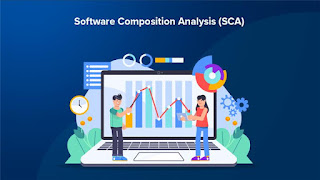Protecting Your Software Supply Chain with Software Composition Analysis
In today's fast-paced software development landscape, the
use of third-party components—especially open-source software (OSS) and
commercial off-the-shelf (COTS) products—has become ubiquitous. These
components significantly accelerate development, reduce costs, and enhance
functionality. However, embedding these external elements within proprietary
applications introduces potential security vulnerabilities, licensing
challenges, and quality issues that can jeopardize the entire software project.
This is where Software
Composition Analysis (SCA) plays a crucial role.
What is Software Composition Analysis?
Software Composition Analysis (SCA) is an automated process
that systematically analyzes an application’s source code, binaries, or
software bill of materials (SBOM) to identify all embedded third-party
components, with a special focus on open-source and COTS libraries. SCA tools
scan the entire codebase continuously or at various stages throughout the
software development lifecycle (SDLC), detecting the presence of components and
assessing their associated risks.
The primary goal of SCA is to uncover and manage security
vulnerabilities, compliance issues, and quality concerns related to these
third-party dependencies before they can impact the application or business
negatively.
Key Capabilities and Functions of SCA Tools
Component Identification and Inventory Management:
Software
Composition Analysis tools provide comprehensive visibility into all
embedded components within the software, including nested and transitive
dependencies that might not be immediately obvious. This detailed inventory, or
software bill of materials (SBOM), helps organizations understand exactly what
third-party code is present.
Security Risk and Vulnerability Detection:
One of the most critical features of SCA is its ability to
identify known security vulnerabilities linked to components in use. By
cross-referencing component versions against public vulnerability databases
such as the National Vulnerability Database (NVD) and vendor advisories, SCA
tools detect issues like buffer overflows, cross-site scripting (XSS), and
other exploits. They typically prioritize vulnerabilities based on severity and
exploitability, enabling security teams and developers to focus remediation
efforts where they matter most.
License Compliance Analysis:
Every open-source component is governed by a license that
stipulates how it can be used, modified, and redistributed. Non-compliance with
these licenses can lead to legal and financial risks, including intellectual
property disputes. SCA tools analyze the licensing terms of each component and
alert organizations if their use conflicts with corporate policies or poses
legal exposure.
Quality and Maintenance Assessment:
Beyond security and licensing, Software Composition Analysis
solutions often evaluate the quality and maintenance status of components. They
may flag outdated libraries, components with a high rate of bugs, or those that
have become unsupported. This insight helps development teams make informed
decisions about upgrading or replacing risky dependencies, contributing to
overall application stability and maintainability.
Operational and Project Viability Insights:
Some advanced SCA tools extend their analysis to operational
risks, such as how frequently a component is updated, the responsiveness of its
maintainers, and the activity level of its open-source community. Such data
helps organizations assess the long-term viability of including a particular
component in their projects.
Integration into the Software Development Lifecycle
Software
Composition Analysis is most effective when integrated seamlessly into the
SDLC. Instead of being a one-off security checkpoint, modern SCA tools support
continuous monitoring from the earliest stages of development through
deployment and ongoing maintenance. By embedding SCA into Continuous
Integration/Continuous Deployment (CI/CD) pipelines, organizations ensure that
each build is automatically scanned for vulnerabilities and compliance issues
before release.
This proactive approach shifts security and compliance
“left” — earlier in the process — empowering developers to remediate issues
quickly and efficiently. Early detection helps reduce the cost and complexity
of fixes, which can be exponentially more difficult if vulnerabilities are
discovered late in production.
Benefits of Implementing Software Composition Analysis
Improved Security Posture:
Identifying and addressing known vulnerabilities in
third-party components greatly reduces the attack surface of applications,
protecting sensitive data and preventing costly breaches.
Legal and Compliance Assurance:
By verifying licensing compliance, organizations avoid
potential lawsuits and penalties that arise from improper use of open-source
components.
Enhanced Software Quality and Reliability:
Monitoring component quality and maintenance status promotes
stable, maintainable codebases and reduces technical debt.
Faster Time to Remediation:
Automated alerts and prioritization of risks enable faster
response by both development and security teams.
Cost Savings:
Preventing security incidents, legal issues, and extensive
rework results in significant cost savings over time.
Challenges and Considerations
While Software
Composition Analysis tools provide substantial benefits, successful
adoption requires organizational alignment and process adaptation. Challenges
include:
Managing False Positives:
SCA tools can sometimes produce alerts that require
contextual analysis to assess real risk.
Handling Legacy and Complex Dependencies:
Older applications or those with complex dependency trees
may pose difficulties for accurate component detection.
Balancing Security and Development Velocity:
Integrating SCA into CI/CD pipelines should avoid
bottlenecks that slow down deployment schedules.
Keeping Up with Rapidly Changing Open-Source Ecosystems:
Vulnerability databases and licensing data are constantly
evolving, so SCA tools must be regularly updated.
Conclusion
Software Composition Analysis has become an indispensable tool in modern application security and development processes. By automating the discovery and risk assessment of embedded open-source and commercial components, SCA empowers organizations to mitigate security vulnerabilities, ensure legal compliance, and maintain high-quality software. Integrating SCA into continuous development workflows not only strengthens the security posture but also supports efficient, risk-aware software delivery. As reliance on third-party software components grows, adopting robust SCA solutions is no longer optional—it is essential for building trustworthy and resilient applications.
.png)


Comments
Post a Comment